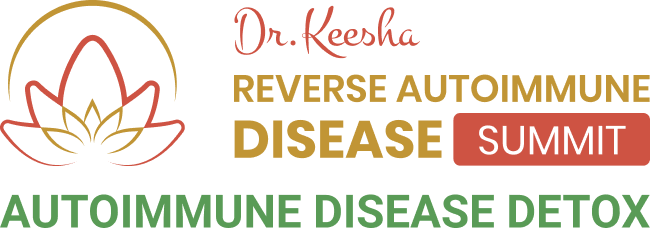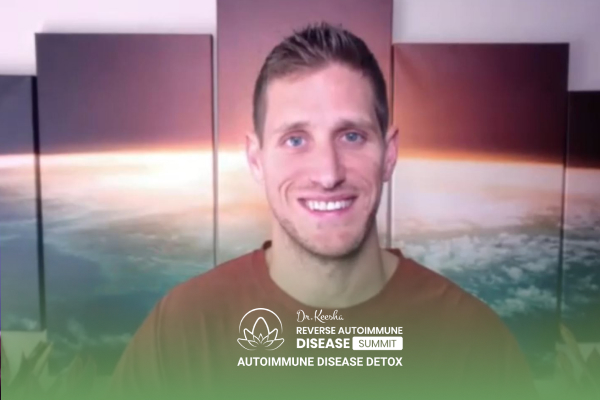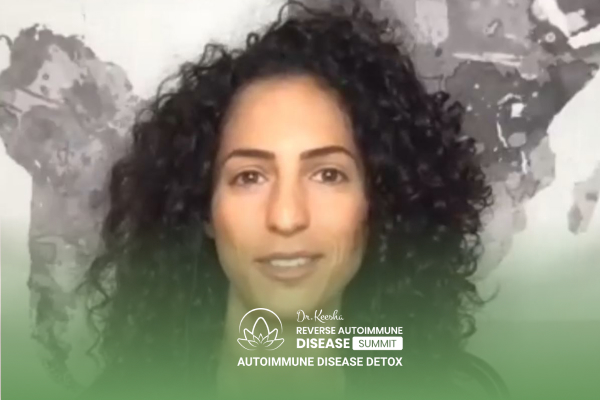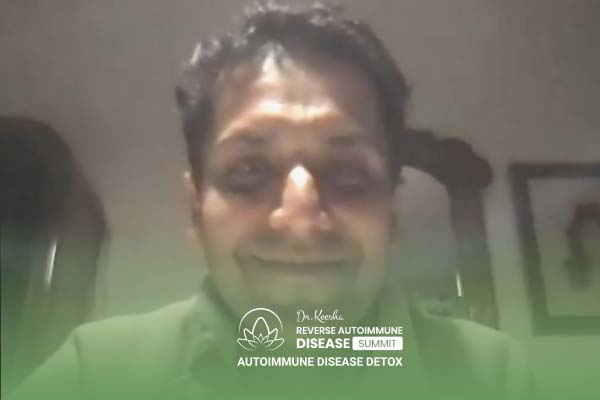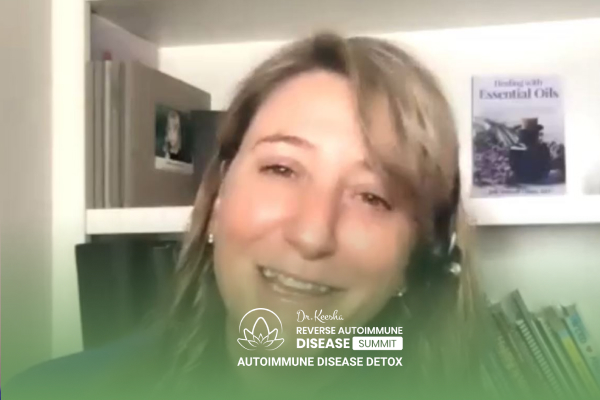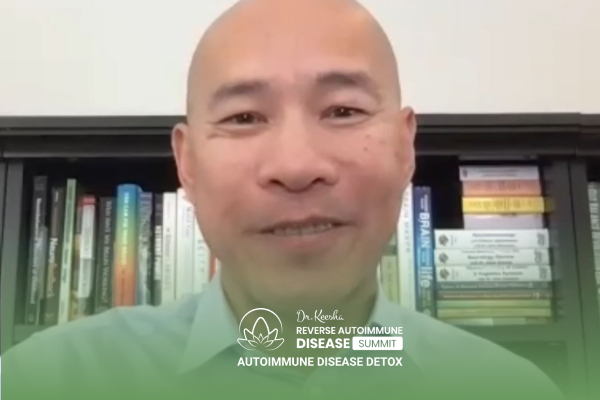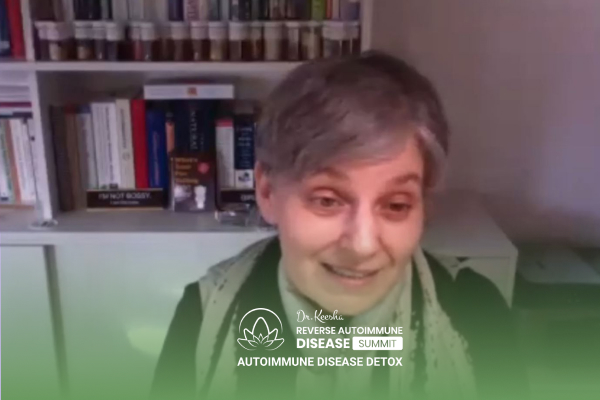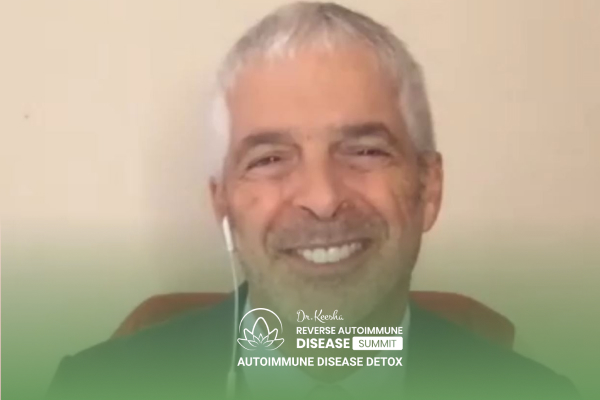Join the discussion below
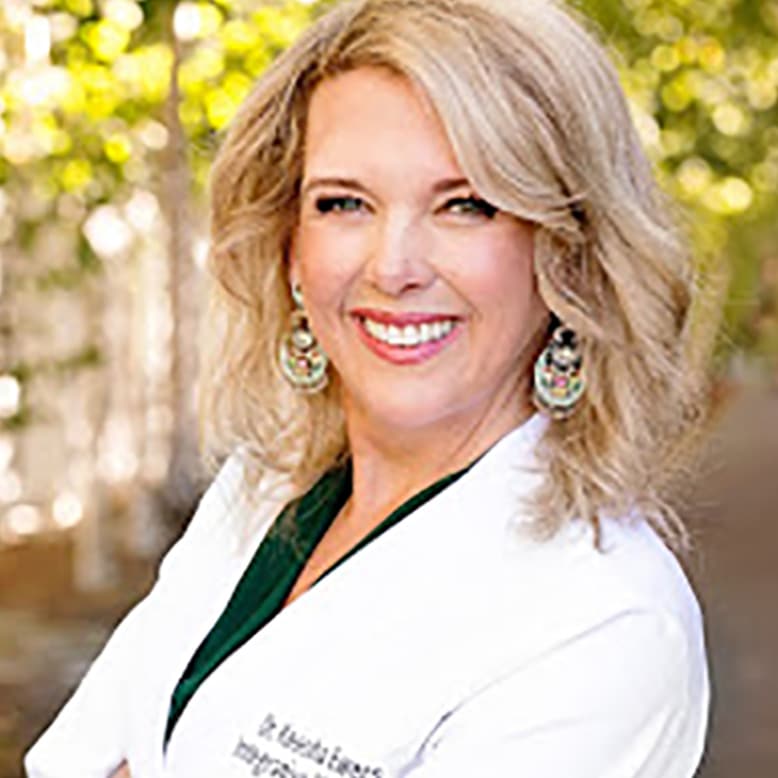
Keesha Ewers, PhD, ARNP-FNP-C, AAP, IFM-C
Dr. Keesha Ewers is an integrative medicine expert, Doctor of Sexology, Family Practice ARNP, Psychotherapist, herbalist, is board certified in functional medicine and Ayurvedic medicine, and is the founder and medical director of the Academy for Integrative Medicine Health Coach Certification Program. Dr. Keesha has been in the medical field... Read More
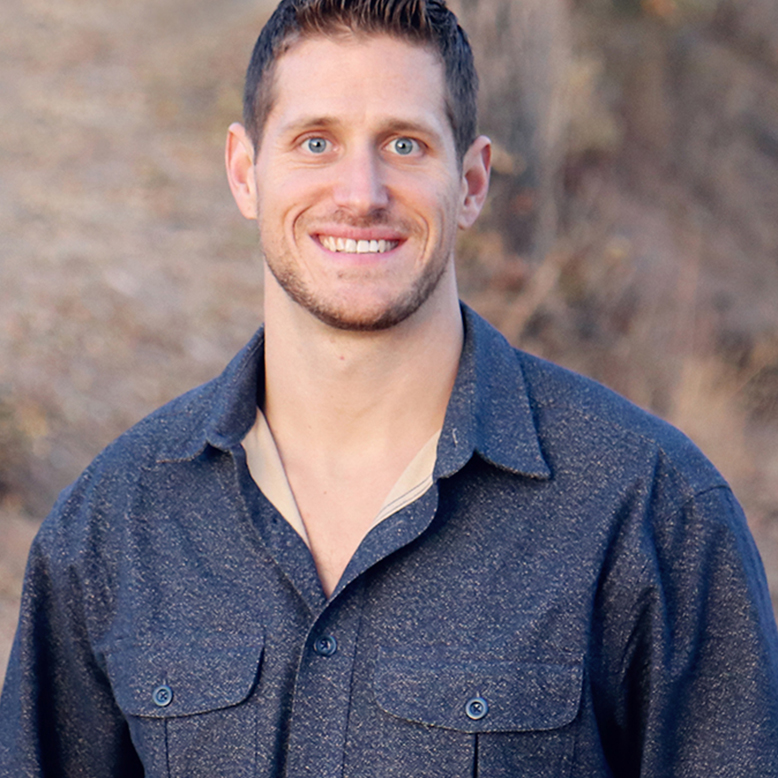
Nathan Crane is an award-winning author, inspirational speaker, plant-based athlete, event producer and 18x award-winning documentary filmmaker. Nathan is the Founder of The Panacea Community, Creator of the Global Cancer Symposium, and Director and Producer of the documentary film, Cancer; The Integrative Perspective. He is also the Director of Strategic... Read More
- Why cancer can cause autoimmunity (and vice versa)
- The intense danger of normalizing disease
- What we can learn from the world’s healthiest “Blue Zones”
Keesha Ewers, PhD, ARNP-FNP-C, AAP, IFM-C
Welcome back to the Reverse Autoimmune Disease Summit everybody. Of course is the 4.0 iteration the autoimmune detox. And I am delighted to introduce to you if you have not already run into his work, Nathan Crane, who’s an Award-Winning Author, Inspirational Speaker, Plant-Based Athlete, Event Producer, and 18 times Award Winning Documentary Filmmaker. Nathan’s the Founder of The Panacea Community, Creator of the Global Cancer Symposium, and Director and Producer of the documentary film, Cancer, The Integrative Perspective. He’s also the Director of Strategic Relations at the Chief Center and as the Assistant Director of the PBS series Ageless Living. In 2005 at all 18 years old, Nathan began has health healing and spiritual journey. Eventually overcoming a decade of brutal teenage addiction, house arrest, jail, and challenging times of homelessness to become an international author, filmmaker and speaker dedicated to health, healing, and conscious awakening. Welcome to the series Nathan
Nathan Crane
Dr. Keesha. Thank you so much. Thanks for having me. Really excited to be here with your audience tuning in
Keesha Ewers, PhD, ARNP-FNP-C, AAP, IFM-C
You know, I was recently on the cancer symposium that you put together the integrative cancer symposium. And I would love to, I know this is the auto-immune detox, but these things are related. And I wanna take us on a journey of auto-immune disease and the cancer connection, and this idea of toxicity and how this shows up in our bodies. And I know when I was looking at your website before our interview looking at your work, you talked about, I think there was something in there that said, what chance you’re really is. And I would love for you to do a little synopsis about that.
Nathan Crane
Absolutely. So, you know, I think it’s a good place to start with what diseases? Right? Because as you said, there are a lot of commonalities and I can share some of those commonalities between autoimmune disease and cancer and why this is really important to understand, whether you have cancer, you have autoimmune disease or you have both, right? Because there’s actually not only commonalities in cause causation but there’s also commonalities in solutions. And there’s also higher risk of cancer. If you have autoimmune disease and vice versa which a lot of people don’t realize, right?
So that information, you know we can get into not only the causes so we can eliminate some of those causes from our lives for your tuners tuning in, but also get into solutions practical things you can do some you may know of and some you may not. Right. So what, when we look at disease in general is big bucket of disease, right? So here’s how I look at disease. I look at it as the analogy of a tree, right? Let’s say an apple tree, or an orange tree or you pick your favorite fruit tree, right? And basically the reality is disease is common today but doesn’t have to be normal. It does not have to be our normal. I wrote an article about this years ago, that we live in a society where we normalize disease. We think, you know what, as you age, it’s a part it’s a normal part of aging is to get some disease, right. Or two, or three, or four diseases. And the reality is that doesn’t have to, it may be normal in our current society may be common but it doesn’t have to be normal. And the proof of that is when you look at blue zones and you talk to people who live in blue zones, when you meet people,
Keesha Ewers, PhD, ARNP-FNP-C, AAP, IFM-C
Just define that to people that are unfamiliar with that term.
Nathan Crane
Yeah. Yeah. So, so blue zones are the, some of the places around the world that have been studied more recently in the past few decades. Where people live the longest and healthiest with the least disease. Right? And so we’re talking to people in their eighties and nineties and even a hundreds. You know, these places often have the most centurions who live on the planet. People a hundred plus who have in many cases, no diseases whatsoever. Right. And they don’t live the perfect lives. And they’re, you know, they still have some things you might, you know, bad. You, you might question or you might, you know really that’s how they live? But the reality is there are these pockets of people and culture, when you go and study them, like my friends over at the Art of Anti-aging have done and done a great documentary series about, I’m sorry, not the Art of Anti-Aging, that’s Brian, the Human Longevity Project. So,
Keesha Ewers, PhD, ARNP-FNP-C, AAP, IFM-C
Jason Prall, yeah
Nathan Crane
Yeah the Jason Prall who’s a friend and colleague of mine. And,
Keesha Ewers, PhD, ARNP-FNP-C, AAP, IFM-C
I too, we will have to talk about that.
Nathan Crane
A couple of a times and ask him, so what are those commonalities, right? And really basically the reality is without getting into all those details, the reality is in our higher potential being human beings disease is not normal. Actually normal, our potential is to live 80, 90 a hundred without drugs, right? Without pharmaceuticals, without conventional medicine in many cases. Without disease, right? Happy, healthy, living long lives. So that’s our potential. And that’s kind of the framework we wanna build this under is a disease is common but it doesn’t have to be normal. Right? So these blue zones, you study the people well, they move all the time.
They don’t always eat the exact same foods but the foods they do eat are not processed, are not, chemicalized, are not filled with high sugars, right. They have great relationships. They’re connected to the earth. They, you know, more things we can get into as we get into solutions. But just to give your audience a little bit of an idea they live much closer to earth, much closer to living from the space of coming from their heart. Right. They’re connected to their local community. They have happiness in their lives every day. They move every day, sometimes walking a mile two miles every day. They’re not going to the gym and working out like we have to nowadays right. To, to get our movement in, in many cases, you know they’re moving, they’re picking up boulders they’re working in the garden, they’re hauling water they’re doing things and they’re happy
Keesha Ewers, PhD, ARNP-FNP-C, AAP, IFM-C
And they’re
Nathan Crane
they’re happy without disease.
Keesha Ewers, PhD, ARNP-FNP-C, AAP, IFM-C
They’re intergenerational is another piece of that.
Nathan Crane
Absolutely. So again, we can talk more about that but I wanna share about, this analogy of a tree, right? So the big blanket of disease, whatever disease it is. So if we look at a tree I really compare a tree to the human body, right? How do you make a tree thrive, to live to that potential of living without disease? Well, number one, it needs a few key things, right? It needs clean air. It needs clean water, and it needs clean nourishment. It needs nutrients, right? And so it needs an environment that’s conducive to the thriving of that tree. And so when it’s getting the right nutrients from the soil the bacteria that’s in the soil, the, you know, the the leaves fall, the fruit falls the animals die, creates compost. That nourishes it’s the soil it’s the nourishment, the food, the supplies the nourishment so that tree so could thrive. It’s that clean air coming in without the pollution. It’s the, you know, I was in Mexico visiting my wife’s family, and you know, you’re in the jungle where we were away from the city, but near a major road where lots of vehicles drive by, right? Lots of semi-trucks, lots of cars are driving every single day and you’re in the jungle. And you’re like, wow this is the most pristine, beautiful place. But you look at all the trees and they’re just covered with this black soot, right. It’s just as black, like the loo you can wipe the black off. What is that?
That’s a pollution coming from the vehicles. And yet these trees, even in this polluted environment are still able to thrive because they’re resilient just like the human body, right? That’s how we can go decades with totally polluting our bodies, our minds, our emotions even our suppressing, our spiritual expression without having any diseases really show up until 30 or 40 years later, 50 years later which is what often happens, right? Because the body’s super resilient even if we’re polluting it like crazy. But you give it that clean air, you give it that clean water that’s not polluted. Well, that tree with the right nourishment is going to thrive for decades and decades, right? Producing so much fruit, producing you know, the self-sustainability, it’s gonna grow big giant branches, is gonna be healthy, right? And that’s the potential of the human body. But what happens, when it doesn’t get the nutrition it needs? When it doesn’t get the clean water, the clean air the environment that it needs to thrive?
Well, then it starts to suppress its potential. And it doesn’t grow as big, number one. Number two, it may start to get some actual diseases, you know some infections in the tree. And you’ve seen, you know entire forest wiped out because of infections, right? Because of this ease in forest, because those trees were not healthy. The environment was not conducive for them, right? And it may even stop growing a branch, right? The branch may die completely die to conserve energy within the core of the tree to keep it alive, to keep producing, you know energy for its main potential, which its main potential is is producing delicious, healthy fruit for, you know whatever beings on the planet wanna eat it. Right?
But it’s also cleaning the air and it’s supporting the microbes and it’s it lives in a very collaborative environment, right? So it’ll do everything. My point here being, is that the tree just like the human body, will do everything it possibly can to keep itself alive. And that’s what cancer is cancer like a tumor, for example that’s what a tumor is, I should say. A tumor is your body wrapping up these malignant cells to try and keep your body alive. So people who have a tumor, for example feel like I need to get this cut out of me as quick as possible, because it’s bad. It’s bad. Right? And often the oncologist will also, you know encourage you to remove it as quick as possible. But what you don’t realize is that tumor is actually prolonging and saving your life. So it’s not necessarily horrible and you need to remove it right away. It’s actually been forming in your body for years and in some cases, decades.
So it’s actually preventing your body from dying, just like that tree may cut off its own branch. It may stop sending energy to a branch so that branch can die off to conserve the energy to keep the rest of the tree alive. Your body does the same thing. And that’s what cancer is. So when we look at all disease in general, right? It is a tree or a human body that is not getting the nourishment and the environment that it needs to thrive. And when it does that tree thrives and your body thrives, right? And so that’s the key, is learning, what are those things that are causing the infections to happen that are causing the inflammation to happen, that are causing the immune system to attack the cells within the body as an auto-immune disease that are causing your body to produce more cancer cells every single day then your immune system can remove, right? And so figuring those things out it’ll give you the foundation you need for healing for health and for longevity
Keesha Ewers, PhD, ARNP-FNP-C, AAP, IFM-C
You know, the same can be said about the current virus that we’re all talking about today. There’s a seems to be a forgetting that our virons is part of our microbiome, which is we are 45% viral. And if we go in and start killing one thing that’s trying to give us information our global right interaction with our innate immunity with the global innate immunity, where we’re just so narrow in our scope, we focus on the tumor, we focus on the disease, we focus on the virus instead of this overall picture of imbalance and what needs to happen. And so this is a really beautiful way of putting it.
And I love the picture behind you because of course, you know, that’s actually what we need to be looking at is a more expansive picture of what’s happening rather than narrowing in on this one thing and then wanting to kill it. So there’s always this thing about war on everything and auto-immune diseases war within yourself. Right? I fought cancer and I beat it. I always go, ah, that’s the definition for autoimmune disease, right? Being at war with yourself, there’s actually no winner. So I love the way that you put that. It’s really beautiful. So finding solutions then, before where this imbalance is coming from.
Nathan Crane
Yes. So let’s talk a little bit about, you know, the commonalities right between autoimmune, autoimmune disease and cancer. Because a lot of people that’ll help lay the framework, the foundation, so when we get solutions, it’ll make more sense, right? So some of the most common things that we can identify between autoimmune disease and cancer is one, they’re both immune related, right? And people who don’t know a lot about cancer, right? I’ve been in the natural health field for 15 years. I’ve been specifically focused, heavily on research. I’m interviewing the top world leading experts, you know dealing with cancer in my own family, my grandfather passing, not from just cancer but from the conventional treatment of chemotherapy and radiation from cancer that kinda set me on this path, you know, eight years ago.
So, 15 years in the health field and eight years dedicated to cancer, right. And learning everything I possibly could about. So I could help, not only my family but everybody else would come in contact with. So we don’t have to be afraid of it any longer. And what you find out is cancer as immune-related just like auto immune diseases, right? Auto immune is really, the immune system ends up attacking healthy cells in the body which the science is now showing us that’s primarily due to gut permeability right? Leaky gut, toxins, you know, the leaking out of the intestines. And then the whole thing that happens. I’m sure you have a lot of experts speaking on that. We don’t have to get into the science of it, but the cause of that also is, you know, toxins unhealthy diet, unhealthy lifestyle, you know these unhealthy environment and so forth,
Keesha Ewers, PhD, ARNP-FNP-C, AAP, IFM-C
And causes,
Nathan Crane
And Yes. Unhealthy thoughts, exactly. The causes that gut permeability that allows, you know this mechanism to happen. Well, cancer is the immune system weakened, right? Which, through DNA damage and cell fermentation, right? Also that due to toxins and unhealthy diet, unhealthy lifestyle and unhealthy thoughts, right? Stress, anxiety, depression, chronic fear. So they’re both, immune-related very similar. Now the function is different, but again, they’re both immune-related just like COVID, just like this virus, just like this pandemic, it’s immune related. If you have a strong, fully functioning immune system you have nothing to worry about with any virus. I feel so confident in that for myself and my family, my colleagues, our community, the problem is most people dealing with autoimmune disease cancer or any chronic disease, do not have a fully functioning immune system.
So yes, having some sense of concern about, you know having being infected with any virus of course there is a cause for concern there, but the focus should be on the immune system.Right. Not on, you know, hiding ourselves away. And this is my personal opinion. You don’t have to endorse us for your summit, but not hiding ourselves away, lock ourselves inside which houses are full of more toxins than outside in most cases, wearing a mask, being in chronic fear, suppressing the immune system, you know lathering ourselves in heavy you know, heavy chemicals a suppressed immune system, even worse.
Those are not real solutions, right? Real solutions are things that are going to enhance your immune system that are going to support your body’s ability to heal. So the second thing that auto immune disease and cancer have in common is they’re both inflammatory, right? They’re both based in inflammatory conditions in most cases, right? Many auto-immune diseases can lead to chronic inflammation in the body. Well, what happens with chronic inflammation of the body is you get this DNA damage and repair. It’s this constant thing. So you get damage repair, damage, repair, damage, repair. And what happens is that creates this opportunity for cancer cells to start to grow and proliferate. And over many months and years of that, damage, repair, damage, repair, damage, repair through chronic inflammation that leads to cancer, right? So they’re both in many cases, inflammatory related. The third thing that makes them, you know really, the third commonality between them is that they both have similar effects from conventional treatments, right.And whoever takes conventional treatment, it’s totally fine. I don’t tell people you don’t have to do conventional treatment or you shouldn’t or anything like that. That’s an individual choice for each person, right? But the reality is,
Keesha Ewers, PhD, ARNP-FNP-C, AAP, IFM-C
I agree.
Nathan Crane
Some medications used to treat auto-immune disease can actually lead to cancer. They’ve been proven to cause cancer, and many medications for autoimmune disease only treat symptoms, right. But they don’t cure the disease. They don’t cure the underlying cause, they are a management system that actually can even cause cancer down the road. Well, the cancer drugs are basically the same thing, right? Many cancer, drugs and cancer treatments today, chemotherapy, radiation even surgery, in some cases destroy the immune system. And many of these drugs and treatments also can destroy the gut and the lining and the intestines, and which will open the door for not only more cancers, but then open the door for auto-immune disease down the road. Right? So the correlation between these two is so significant.
And so here’s the fourth kinda important piece about this is that, some auto immune diseases actually put you at a higher risk of developing cancer. So if you have immune disease and you’re concerned about cancer, the reality is, you know any inflammatory bowel, autoimmune disease, for example it causes chronic inflammation and we know chronic inflammation can cause cancer. So that’s one example. Another example is, you know, I found a study where like if you have rheumatoid arthritis, for example, and you smoke cigarettes, you have a 40% higher risk of developing lung cancer than those who smoke but don’t have rheumatoid arthritis. And there’s lots of these studies now where it’s the information is becoming more and more clear between the links between the two right?
That, you know, autoimmune disease is a pre, can be a precursor to cancer. And so these commonalities are really important to understand. And so, because the causes are so similar. So let’s talk about some of those causes briefly, I’ll just go through them quickly. And then we and then if you wanna focus on maybe a couple of core causes, we could talk about a couple of core causes and also, you know, solutions, right? Because really, when I was interviewing for my documentary Cancer the Integrative Perspective it was a five-year project, right? And Dr. Sunil Pai, who’s an integrative MD, you know he really helped to consolidate the core causes of cancer into six core causes. So I call these the core, six core causes of cancer, right? Because if we were to list out every cause we’d have hundreds, maybe thousands. But you can really compile all of those into six. And those six are inflammation which we talked about, right? Elevated blood glucose, is number two. The third is environmental toxins. The fourth is stress, we talked a little bit about that. The fifth is unhealthy diet. And unfortunately, today there’s so much information and misinformation out there about the diet, that people are so confused and don’t know what to do. So here, you know, it’s like I’ve looked at the hard science on this and interviewed the leading experts that work hands-on with thousands of patients every single year.
Keesha Ewers, PhD, ARNP-FNP-C, AAP, IFM-C
And I’m pretty sure you’re gonna say the carnivore diet is not an anti-cancer diet.
Nathan Crane
Oh no. I was gonna promote the carnivore diet. Right? Isn’t that the one that’s going to heal cancer? Right I’m being
Keesha Ewers, PhD, ARNP-FNP-C, AAP, IFM-C
Please know that that was sarcasm everybody.
Nathan Crane
The fifth one is unhealthy diet, and the sixth is lifestyle behaviors, right? So here’s the reality, many of the solutions for cancer they’re also the same solutions for autoimmune disease. So that’s a great thing. If you have autoimmune disease and cancer, you have autoimmune disease and you have a higher risk for cancer, or you have cancer and you’re wanna avoid auto-immune disease, or you’re trying to heal one or both, right? You have a family member you wanna help. Many of us, whatever of these solutions you do specifically for cancer, will support auto-immune and vice versa. That’s the beautiful thing. So talking about meat and dairy, the carnivore diet, for example, right? So since the year 2000, well lemme back up a second. The number one solution that I want to talk about today and there’s a lot of solutions, but let’s just focus, number one is you gotta reduce chronic inflammation. We know these are inflammatory conditions. We know chronic inflammation causes cancer, exacerbates cancer, it makes cancer grow. We know chronic inflammation, you know, is both a cause as well as a symptom,
Keesha Ewers, PhD, ARNP-FNP-C, AAP, IFM-C
and an occurrence.
Nathan Crane
Of autoimmune disease, right? So we know we have to address it. Now we also have to address what’s causing that inflammation. And we know for a fact, scientifically no matter what these guys are writing in the carnivore diet and people I’ve even interviewed who are supposed to be health experts, that disagree with me on this. We know for a fact, when you look at the hard data the decades of scientific research, the major meta-analysis that have been done, for example from the year 2000, that have looked at hundreds of studies for example, in thousands of thousands of people, we know that meat is a significant risk factor for cancer meat and dairy animal products. Now primarily red meat, is even higher risk but actually all meat. Why? Because it causes inflammation in the body, right? Meat, for example, produces something called TMAO, right? And that’s from carnitine, and carnitine is found in animal tissue. And it is not any essential nutrient for human consumption. We do not need it to survive.
We do not need protein from meat to survive. There’s not a single human being that needs meat to survive. Lemme rephrase that. Dr. Joel Fermin, who’s a medical doctor. That’s worked with thousands and thousands of patients hands-on helping, them to heal and prevent and reverse all kinds of chronic diseases by changing diet and lifestyle. He has found, less than one out of a hundred, right? So it’s not even 1% less than 1%, of people who when he switches them to a plant-based diet their body has a hard time. Initially not forever, initially assimilating plant protein. So what he might do for a short time is given some fish and eggs while their body heals itself, to adapt to assimilate that plant protein. Those are very small cases once in a while. And, you know, you gotta test and find out it has nothing to do with the blood type, the blood type, you know thing is already been massively debunked the blood type diet. It’s been totally debunked. If you look at the hard science on that, every single person on the planet can thrive in a plant-based diet, but you have to know what you’re doing. You have to know,
Keesha Ewers, PhD, ARNP-FNP-C, AAP, IFM-C
Some people will say, Twinkies are a vegetarian diet.
Nathan Crane
They are chinos right? The You can be vegan and its totally unhealthy.
Keesha Ewers, PhD, ARNP-FNP-C, AAP, IFM-C
So unhealthy.
Nathan Crane
It’s not about being vegan. It’s about the foods you’ve put into your body. That’s the biggest takeaway here. And we do know for a fact, I’m talking so let’s talk, cancer let’s talk inflammation. We know that meat and dairy causes inflammation in the body through TMAO, through AGEs right? These are reactive monocle, reactive molecules that are that are found in animal products for example, we know that the blood levels of AGEs correlate to markers of inflammation such as your C-reactive protein, your CRP, right? Your tumor necrosis factor. All these things that are leading to chronic inflammation in the body. We know that saturated fat, which is found primarily in meat and animal products also not only increases inflammation but it shows that, you know, studies that have high saturated fat dietary intake immediately increase inflammation and oxidative stress on the body. You know, oxidative stress on the body produces more cancer cells, right? Because it results in a restriction of blood vessels increase in blood pressure, all these things. I mean, we could go on and on it increases triglycerides in the blood.
It does all kinds of things. Now the worst culprits. And this is so, lemme frame this first by saying this is absolutely a hundred percent true for this facade we’ve been taught about grass fed, you know, free range organic. Yes. Those are a better choice if you absolutely will not change from eating meat. No problem. I will never judge you totally fine. Yes. When people say a better choice is grass fed free range organic, absolutely. It is a better choice. We know that processed meats, cured meats you know, lunch meats, salamis these kinds of things are actually known carcinogens. We know for a fact, those cause cancer, we know for a fact they’re incredibly unhealthy for your body even more so. So yes. Fish, chicken, you know if it’s a wild caught, all that stuff. Yes, It’s gotta be healthier for you but absolutely it still does all of these things I just talked about and does increase inflammation in the body, does increase triglycerides, does increase AGEs, does increase TMAOs, all of these things we need to avoid increasing when we have cancer.
So it’s not just coming from me. It’s from every major medical doctor that I’ve interviewed who works hands-on with thousands of patients, they do always encourage their cancer patients to go on to 100% plant-based diet, massive diversity in those plans really important. We could talk a little bit about what that diversity should look like or as much plant base as possible. We know some people just will never stop meeting there. I grew up in Montana hunting our own deer fishing, right? Meat and potatoes. Like that’s how I grew up, but I also grew up really sick. You know, I had that fortune to get to really destroy my body early on and get sick early on. So by the time I was 18, I was ready for a massive change. Right. You talked a little bit in my bio, right? I was addicted to drugs and alcohol as a kid growing up, I was homeless on the street at 15 years old, eating hamburgers at Burger King and McDonald’s and Wendy’s and you know, eating really, really bad food. By the time I was 18, I mean, I was almost dead literally. I was mentally, emotionally, spiritually dead and my body was dying. So at 18 I made a drastic change in my life.
I moved to California. I started my whole life over and I decided to learn everything I possibly could about getting healthy, being healthy, you know, taking care of myself. It’s been a 15 plus year journey now. And so I know what it’s like to be sick. I know what it’s like to be unhealthy. And it was like to not have energy to have digestive issues, all that stuff. And now I know what it’s like to be the opposite of that as well. And that’s the hope I wanna give people, is that when we clean up our diets, right, we’ve gotta get rid of the things that cause inflammation, meat, and dairy. We’ve got to get rid of the fried foods. We know those are carcinogenic. We know that they increase inflammation, crazily.
We got to get rid of the processed foods, the stuff that’s made in laboratories and stuff that is not real food, right? We need to get rid of that. We know we have to reduce carbohydrates if you have cancer. And in many cases, even autoimmune disease, right? And I’m not promoting a ketogenic diet here specifically but higher, healthier fats avocado, coconut oil, these kinds of things, coconut oil is a saturated fat but it’s got a medium chain triglycerides in it which actually contradicts the inflammatory aspects of saturated fat and creates an anti-inflammatory and a healing response within the body. So that’s why people go, Oh yeah but all saturated fats are bad, no. Saturated fats from animal products are bad, but from like coconut oil things like that, they’re not bad for you. They are actually really good
Keesha Ewers, PhD, ARNP-FNP-C, AAP, IFM-C
I got a point to, also research shows that you can get a 25% reduction in high-sensitivity C-reactive protein by reducing a carbohydrate load. So when you hear Nathan say, plant base that does not mean pasta. You know, we’re not talking about beer and we’re not talking about pasta, and we’re not, you know talking about French fries. That, you know you have to reduce that kind of carbohydrate also an addition to what he’s talking about.
Nathan Crane
Yes. It’s so important. And if you have cancer, you need to reduce fruit too. We know fruits, super healthy. Apples, bananas, this things, but because we know cancer thrives and a high glycemic index
Keesha Ewers, PhD, ARNP-FNP-C, AAP, IFM-C
High Sugar
Nathan Crane
Thrives on sugar, it can also, here’s the thing that people don’t realize about cancer cancer can adapt. So that’s why keto doesn’t necessarily always work for cancer because cancer there are some cancers that actually thrive on ketones. There are some cancers that will thrive in a low sugar environment. So even though we know glucose is the number one fuel source for cancer, cancer can adapt and thrive on at least three different fuel sources that we know of maybe even for now, right? So it’s not necessarily like, Oh I have to go total ketogenic or have to avoid carbs a hundred percent or whatever. No, it’s finding the balance. It is reducing those carbs, not
Keesha Ewers, PhD, ARNP-FNP-C, AAP, IFM-C
That’s being a blender full of fruit, or juice seeing a ton of fruit, please don’t use fruits.
Nathan Crane
Yes. You know, all about it. Do not juice fruit, do not,
Keesha Ewers, PhD, ARNP-FNP-C, AAP, IFM-C
Do not juice fruit you’re mainlining sugar. It’s going up your nose,
Nathan Crane
You know you know, I thought I was on a super healthy diet and I have been, but the reality is even I who is an athlete who I’m an athlete. I train hours a day. I work out hard, high intensity. I’m burning tons of, you know, I don’t know. My body is probably 7%, 8% fat right now, potentially. I don’t have extra fat on my body. I burned those carbohydrates, but I was eating too many carbohydrates and actually was getting digestive issues. Right. Candida overgrowth, parasitic overgrowth, those kinds of things. When you have too many carbohydrates. Because I was doing things like honey which was like healthy sugar, right? The reality is, yeah. Honey is like a medicine. You take a tablespoon once a week. Sure. You get the medicine. You’re, you’re adding it every day in your tea, like I was, well now you’re overloading on sugar. I mean 17 grams of sugar in a single tablespoon of honey. Is insane.
Keesha Ewers, PhD, ARNP-FNP-C, AAP, IFM-C
And this apply for maple syrup to everyone, please
Nathan Crane
And maple syrup and a Gavi and all these things, you know you’re better off getting rid of all processed sugars whatsoever. Don’t even do honey, don’t do Maple syrup. Don’t do a Gavi. None of them switched to something like Stevia leaves right? The powder, even the tincture ones the dropper you can get is usually filled with vegetable glycerin and vegetable glycerin is going to affect your body like sugar. Even though they don’t have to put sugar in the label.
Keesha Ewers, PhD, ARNP-FNP-C, AAP, IFM-C
And I like your Monkfruit too without the arithmetic Sila just the pure. Yeah.
Nathan Crane
The Monkfruit is another great option. But again, you know these things better like in powder form where they don’t have any vegetable glycerin added. So get rid of the sugars, don’t drink fruit juice. You know, you do wanna reduce sugars, you do wanna reduce carbohydrates because then the cancer doesn’t have its main fuel source to thrive. But in place of that you want to add green vegetables, green leafy vegetables. We know cruciferous vegetables have tons of research on their healing potential, not only for the gut for auto immune disease, right, but for cancer specifically. or these are things like bok choy and you know you wanna have kale and spinach in your diet and you wanna have, you know even radishes and yes, you can do carrots, but again carrots tend to get higher on the carbohydrate index or less carrots but all your green leafy vegetables, collards.
Keesha Ewers, PhD, ARNP-FNP-C, AAP, IFM-C
I like juice the stems of the broccoli. And I do so in the morning and then I eat the flower heads with their fiber and everything later in the day in a different way. So, you know, you can juice these lower glycemic index screen that have a lot of juice on them in the morning and then eat the rest. I like 12 cups of veggies a day for my people and myself.
Nathan Crane
Nice. Right. And I’ll juice half of that. And then but you gotta make sure you’re not having pure carrot juice. Like.
Keesha Ewers, PhD, ARNP-FNP-C, AAP, IFM-C
Exactly. If you do juice, make sure it’s only green vegetables, right? You could put one carrot in there. You could put a beet in there but have lots of cucumber and celery and kale and
Nathan Crane
Hunks of ginger, hunks of turmeric.
Keesha Ewers, PhD, ARNP-FNP-C, AAP, IFM-C
All that turmeric, cilantro, cilantro
Nathan Crane
Cilantro. detox right, pulls heavy metal out of your body. So, you know, we get to talk about this for all day long but lemme just get through, the so natural anti-inflammatories. Diet number one, number two, add in, you know, herbs and spices and things. As we talk about turmeric, curcumin, boswellia which is frankincense black pepper, these things that are proven to reduce inflammation, leafy greens, berries are a great source of antioxidants and vitamins and they’re much lower on the glycemic index than fruits. So swap out fruit for blackberries, blueberries, raspberries don’t eat dried berries or dry cranberries or dried raisins because
Keesha Ewers, PhD, ARNP-FNP-C, AAP, IFM-C
Nuggets of sugar?
Nathan Crane
More than half of the or the water content. So you’re just getting pure sugar again. Right? These are things like it’s most people we don’t think about because we haven’t been taught this information. You gotta go through the ringer off and to get it. But hopefully everyone here has taken notes and they’re you know, getting some good takeaways here. So number two let’s go to number one, reduce anti-inflammatories. I know we’ve only got a short time left so I’m gonna have to go through these really quick. Number two, you’ve got to reduce stress, right? And why do we have to reduce stress? Well, we know the parasympathetic nervous system versus the sympathetic nervous system. We know for healing, both autoimmune and cancer, we need to be in a parasympathetic state as often as possible.
Which means when you’re in parasympathetic your immune system up-regulates your adrenal system down-regulates, which means your cortisol levels decrease and your ability for immune system to get rid of the cancer cells and to heal the gut and to do what it’s designed to do to help your body heal activates. And so how do we get in parasympathetic as often as possible? Well, good quality, deep sleep, seven to nine hours every night, I did a whole whole talk on the sleep summit coming up all about sleep and cancer. Specifically the science, the data, the, I looked at a ton of research for that, and really to boil it down seven to nine hours every night of good quality sleep. But during the day we have to reduce our stress our anxiety, our fear. Has some great ways to do that. Meditation, qi gong, you know, a yoga practice, a breathing practice, yoga nidra is a great thing to do. You know, as an afternoon meditation nap experience, you know, people go, well I can’t meditate because I start meditating and I fall asleep. Great. You get a nap that’s even better because now your body’s healing when you’re napping. Right?
So adding in 30 minutes during the day minimum. But also other stress reduction practices going outside for a walk in nature, you know reduces stress, going and sitting and watching the waves if you’re near the ocean or sitting and watching, I love watching the sunrise in the morning drinking a cup of tea, reading, you know, good information. Like all the things you can do, turn off the news. You know, the news just puts you in constant fear in a constant state of sympathetic nervous response where now your adrenal systems kicked on, your body’s pumping cortisol. Your immune system shuts off. So when your adrenal systems on your sympathetic’s activated it actually shuts down your immune system. So now your body can heal. And that’s the biggest takeaway here. So we’ve gotta have the stress reduction practices in our life every single day. And the more you can do the better. Just put it that way. How much should I do? As much as you possibly can, right. So let’s talk about a third one here, time restricted eating, right? Both for auto-immune and cancerous is so beneficial. We know that the less food you eat, the longer you live. That’s pretty clear in our science now. And it doesn’t mean starving yourself. It just means not overeating. You know, we know that when you have more fat on your body you are more prone to diseases like autoimmune disease, heart diseases, cancer, right? So we’ve gotta get that excess fat off the body.
And we do that by reducing our caloric intake as well as adding in more movement practices but also the quality of food matters. And one simple thing you can do is time restricted eating intermittent fasting, right? I’ve been doing this most days lately, I stopped eating at 8:00 PM at night. I don’t eat again until 12:00 PM the next day. But during that window now, why do you do this? Well, autophagy, you increase your body’s ability to remove, you know excess waste from the cells and dead cells and all that which you need when you have any disease but it also reduces inflammation. And it allows more time for your body to heal. You know, I used to eat a meal at 10 o’clock before bed and I’d wake up at seven o’clock and eat breakfast. There’s no time in there for my body to heal. There’s no time for my glucose levels to actually, you know reduce there’s no, it’s like my insulin is always spiked. Right?
Because always eating well if that’s your problem too, that’s a simple fix. Two weeks of time, restricted eating. And after two weeks, it’s like the body adapts. You’re burning fat now in the mornings and it’s easy. You’re not hungry. I do have tea. I do use sometimes a little bit of Stevia in it, or maybe a little bit of coconut oil. I don’t always do a hundred percent strict with just water. And I do in the mornings take some herbs, first thing, some enzymes, right? Some probiotics, some herbs to like that time you give your body a chance to rest, but you’re also putting in some things that aren’t gonna spike your insulin but still allow your body to heal, which are like some probiotics and you know, healing herbs, things like that. The moment you put carbohydrates in your body though, you’re taken out of the fasting state. So there’s some great books on it. You can do more research on intermittent fasting and time restricted feeding but for autoimmune and for cancer, this is an absolute must. And it’s actually easy after you get into a routine after a couple of weeks. And the fourth one is
Keesha Ewers, PhD, ARNP-FNP-C, AAP, IFM-C
I do 10 to six. Yeah?
Nathan Crane
Yeah. I’m no longer . You do that, you do ten to six?
Keesha Ewers, PhD, ARNP-FNP-C, AAP, IFM-C
Yeah.
Nathan Crane
But you do. Oh, so you eat, no?
Keesha Ewers, PhD, ARNP-FNP-C, AAP, IFM-C
It’s 10:00 AM to 6:00 PM.
Nathan Crane
Okay. So you have an eight hour eating
Keesha Ewers, PhD, ARNP-FNP-C, AAP, IFM-C
So then that, that way that nighttime, you know, two or three o’clock in the morning when the liver and the lymphatic system there’s nothing else for them to have to focus on. You know, they can really focus on cleaning you out.
Nathan Crane
It’s so, so valuable that you’re doing that. I mean, and the later you eat the less time your body has to heal when you’re sleeping which the purpose
Keesha Ewers, PhD, ARNP-FNP-C, AAP, IFM-C
Right.
Nathan Crane
Of sleeping is for healing. It’s talking about spiritual, mental, emotional stuff as well as sleeping but physically that’s your time to heal. And if you eat too late right now, your body it takes at least two hours for your body to kind of go through its initial digestive stages and for the insulin to start to lower and all that stuff, right? So minimum, you should stop eating. You know, bare minimum is two hours before bed, but three to four hours as you’re doing four hours is even better. Especially you’re dealing with any chronic disease.
Keesha Ewers, PhD, ARNP-FNP-C, AAP, IFM-C
Yeah.
Nathan Crane
And I just said the fourth one, the quick bonus here we’ll offer this as kind of a bonus is what I call medicinal movement. You have to move every day. You’ve got to flush the lymphatic system. You have to get the, you know, for cancer, your immune system finds the malignant cells, the damaged cells, the cancerous cells, sends them through the lymphatic system. Your nodules on lymphatic system have T cells and B cells and cancer killer cells that are killing those cells and trying to remove them from your body. Your lymphatic systems it’s a waste and toxins from your body. Your lymphatic system is doing everything. It’s your waste management system in the body. And its number one pump is movement. You have to, you know move the body to flush the lymphatic system, it’s so critical and you have to do it every day.
If you’re not moving. And you know, we don’t have time to go into the four core aspects of medicinal movement. I have a whole module on this coming up in July, on my masterclass called becoming cancer-free. But basically it’s a combination of strength training, balance training, some hit exercise training. And even for someone who can’t do high intensity at first there are ways to do that, safely and effectively that don’t injure yourself and cardio, you know, cardiovascular training. So you have to be doing a combination of this. This number might scare a lot of people. The minimum amount every day should be one hour. That is what our, US Department of Health and Human Services physical activity guidelines for Americans, right? Recommends for substantial health benefits to reduce the risk of chronic diseases, including cancer, we need to be moving the bodies in these different ways at least one hour per day, five to six days per week. If you’re not doing that, you’re missing out on all the incredible benefits that a what I call medicinal movement has for your body. So get a personal trainer, you know, start to learn how to do some of these other types of movement. Yoga is great. Qi gong is great, jogging, like you know
Keesha Ewers, PhD, ARNP-FNP-C, AAP, IFM-C
And how do you think I’ve stuff everywhere? I mean,
Nathan Crane
I can be there.
Keesha Ewers, PhD, ARNP-FNP-C, AAP, IFM-C
I just pull it up on YouTube and you’ve gotta trainer in your living room.
Nathan Crane
Totally.
Keesha Ewers, PhD, ARNP-FNP-C, AAP, IFM-C
So easy, yeah.
Nathan Crane
Lock up, 20 minutes, at home you know, dental in the health clubs. So I put together an online community called Health and Healing Club. You can check that out healthandhealingclub.com. We are putting in medicinal movement routines in there all the time. That people can gently for back pain, for you know, moving the body gently, for, especially if you’re have low energy, it’s gonna give you more energy. If you are overweight, it’s gonna help you to lose weight. If you have chronic disease, your lymphatic system is not flushing very well. It’s gonna help you flush your lymphatic system and the more you do it, the better you’re going to feel. Right? So,
Keesha Ewers, PhD, ARNP-FNP-C, AAP, IFM-C
Nathan I know that we, you and I have we have, we have to recall this and I could talk to you for another many hours. I know you have a detox ebook that you’ve put together for our followers. That is a free gift. And so we’re going to point everybody to that. And I so appreciate you spending the time. And again, Nathan Crane has a really beautiful website that we will point you to that has many different resources on there. And thank you so much for the work that you’re doing.
Nathan Crane
Absolutely. Yeah. Thank you, Dr. Keesha, so the website, you can just go to nathancrane.com. You can get to our Health and Healing Club from there. You can download the detox ebook from there. She has a lot of great resources for you to how to start embodying more of what we’re talking about here to help your body to heal in the way it was designed to heal. So nathancrane.com. And Dr. Keesha again, thank you so much for having me. I know we could probably talk two or three hours on this.
Keesha Ewers, PhD, ARNP-FNP-C, AAP, IFM-C
Really.
Nathan Crane
I just wanna thank all of your audience. So last thing I want to say to everyone, there is hope if you have cancer, you have auto-immune disease. There is always hope. There are always solutions. There is always the potential for you to experience your higher level potential of health. I want you to walk away knowing that. There are so many people, thousands of people who have reversed, even up to stage four and stage end cancers using natural holistic approaches. And I know people are reversing autoimmune disease every single day. So there’s lots of hope, but you gotta educate yourself. You gotta continue learning from the experts in summits like this. And, you know, I hope to hear from you in your own healing journey in the future and wish you all so much health and success.
Keesha Ewers, PhD, ARNP-FNP-C, AAP, IFM-C
Thank you. Thank you so much. And okay everybody until next time be well.
Downloads
